A decade on, a Greenland rare-earths mine is close to final approval
The controversial Kvanefjeld mine has reached its final regulatory hurdle.

A decision on whether to permit mining at one of the world’s largest deposits of rare-earth elements has moved to its final stage after Greenland Minerals, an Australia-based firm, on Monday filed its assessment of how a proposed open-pit mine at the Kvanefjeld site, in southern Greenland, would affect the surrounding environment.
Greenland Minerals, which has been conducting preparatory work at Kvanefjeld since 2007, must now wait for environmental authorities to complete their review of the assessment, as well as information they receive during a final public consulting period.
Greenland Minerals’ first environmental impact assessment, submitted in 2015, was rejected last year. Since then, the firm has worked closely with regulators to address the deficiencies, including an incomplete explanation of how pools of water used for depositing rubble left over after ore is extracted would affect the environment. In June, company executives met with mining ministry officials following a general election earlier this year that saw the re-election of a mining-friendly government in Nuuk.
While Kvanefjeld is considered primarily a rare-earths mine, getting the minerals (which are used in all manner of modern electronics) out of the ground requires extracting uranium. Greenland Minerals expects that selling the uranium will add to Kvanefjeld’s profitability, but its efforts to get permission to do has been the source of heated discussions in Nuuk and Copenhagen.
[As Greenland nears uranium decision, opponents fear public won’t be heard]
Before uranium mining could be allowed, a Greenlandic law banning extraction of radioactive minerals had to be repealed. The 2013 law-change passed by just a single vote, however, and remains a matter of dispute.
Much of the criticism of the Kvanefjeld mine has centered on concerns that the dust kicked up by activity there would be harmful to residents of the nearby town of Narsaq and southern Greenland’s reputation as an emerging agricultural region.
Although Greenland was granted control of its underground resources in 2009,
Danish lawmakers suggested in 2015 that it should control export of ore from Kvanefjeld, due to concern that the rare earths and uranium could be considered strategic materials.
[Greenland needs money. Is a uranium mine the answer?]
Nuuk and Copenhagen eventually reached an agreement that would place Kvanefjeld’s uranium exports under Danish oversight. And, according to Greenland Minerals, International Atomic Energy Agency inspectors were on hand at Kvanefjeld on August 28 together with Danish and Greenlandic officials to conduct a final review of the site in to ensure that it was in compliance with international laws to prevent the spread of nuclear weapons.
After Greenland Minerals earlier this year announced that it was nearing the end of its review, opponents last month opened a new front in their efforts to prevent the mine from opening by warning that an adjacent historic site risked losing its UN designation if the mine was permitted.
Greenland Minerals representatives said, however, that their assessment indicated that dust from the Kvanefjeld operation would not cause radiation in the area in question to rise above unacceptable levels.